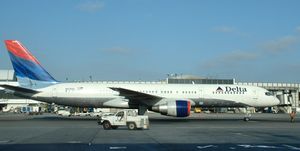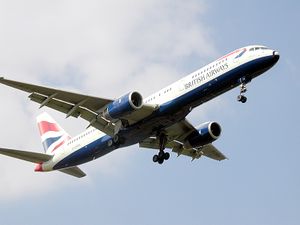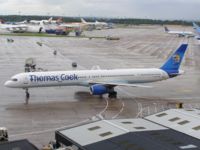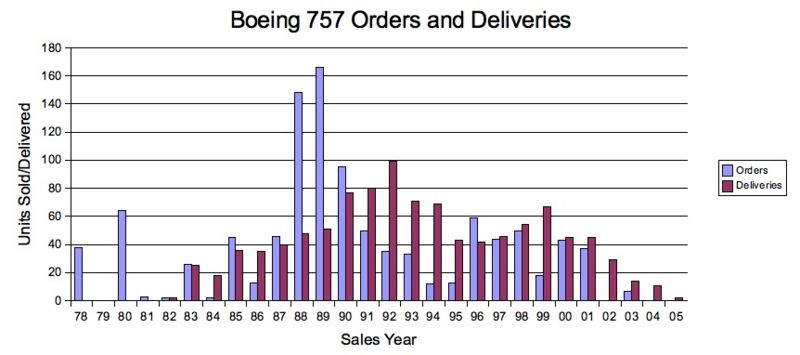PlaneSpottingWorld welcomes all new members! Please gives your ideas at the Terminal.
Boeing 757
| Boeing 757 | |
|---|---|
| Air Greenland Boeing 757-200 | |
| Type | Airliner |
| Manufacturer | Boeing Commercial Airplanes |
| Maiden flight | 1982-02-19 |
| Introduced | 1983-01-01 with Eastern Air Lines |
| Primary users | American Airlines (143) Delta Air Lines (121) United Airlines (97) United Parcel Service (75) Northwest Airlines (67) Continental Airlines (58) |
| Produced | 1982-2004 |
| Number built | 1,050 |
| Unit cost | 757-200 $65,000,000 (2002) 757-300 $80,000,000 (2002) |
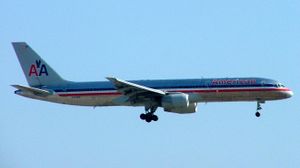
The Boeing 757 is an American medium to long haul commercial passenger aircraft manufactured by Boeing Commercial Airplanes. It was launched by Eastern Air Lines and British Airways to replace the Boeing 727 and entered service in 1983. Production of the 757 ended on November 28, 2005 after 1,050 had been built. The final aircraft was delivered to Shanghai Airlines. As of January 2007 a total of 1,006 Boeing 757 aircraft remain in airline service.[1]
Contents
History
While the program was a resounding financial success, sales dwindled during the late 90s, eventually forcing Boeing to cease production. The 757 (designated "7N7" during initial development) was designed by Boeing to replace the Boeing 727 and complement the Boeing 767 on thin routes. Boeing originally offered the airlines a stretched, re-engined 727-200, known as the 727-300, but this never received enough interest from the airlines to proceed. Early 7N7 and 757 concepts featured a "T-tail" with under-wing engines, but a conventional tail was ultimately adopted. The 757 retains the same upper-fuselage diameter as the previous Boeing 707, 727, and 737.
The 757 is used on heavy domestic routes as well as long routes between North America and Europe. Like the 727 it replaced, the 757 was designed for hot and high climates, such as Mexico City.
The 757 was the first Boeing airliner launched with engines produced outside the U.S., with early customers selecting the Rolls-Royce RB211-535. Pratt & Whitney soon offered the PW2000, launched by Delta Airlines. General Electric offered an engine option early in the program, the CF6-32, but eventually abandoned the engine due to insufficient demand.
For purposes of air traffic control spacing, 757 variants are treated as "heavies", because of their tendency to produce strong wake turbulence.

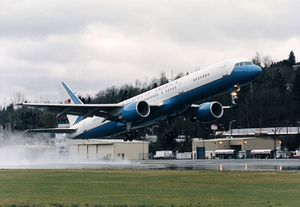
The majority of 757s are in service with U.S. carriers (64% of aircraft in service at November 2006), most notably American Airlines, the largest customer of the type. Delta Air Lines, United Airlines, Continental Airlines, US Airways, America West Airlines (now a part of the US Airways Group), and Northwest Airlines also operate large 757 fleets.
The 757 is also used for holiday/charter airlines in the UK. Thomas Cook Airlines, First Choice Airways, Monarch Airlines, Titan Airways, XL Airways, Astraeus and Thomsonfly operate over 70 aircraft. British Airways profitably runs the aircraft on short routes such as London to Manchester (150 miles) and London to Edinburgh and Glasgow (350 miles), while other airlines have used the 757 for intercontinental routes.
Throughout the program, some viewed the 757 as "too much aircraft" for the role of a 727 replacement. With 20% more seats and a 50% longer range than the 727-200, the 757-200 was clearly not a like-for-like replacement. The nomenclature of the 757-200 suggests that Boeing had considered a smaller 757-100 variant. However, the 757-200 that entered production was too heavy for a shrunken variant, leaving a significant gap between the 757-200 and the 737-300. This gap was successfully exploited by the A320, further propelling Airbus into serious competition with Boeing and McDonnell Douglas.
The 757 maintains competitive economics with newer short haul aircraft like the Boeing 737 and Airbus A320 product lines, following the trend of larger aircraft having lower seat/mile cost. However, changing market conditions do not necessarily favor larger units of capacity. Should passenger loads fall, the smaller 737 and A320 expose the airline to less financial risk. For those airlines in need of large capacity, the A321 and 737-900ER have lower trip cost, albeit with slightly less seats and range. These airplanes fulfill the requirements of 90% of the routes served by the 757, and provide an alternative for airlines already operating 737 and A320 fleets.
The 1,050th and last 757, destined for Shanghai Airlines, rolled off the production line at Renton on October 28, 2004. In the short term, the 757-200 has been succeeded by the 737-900ER. Boeing believes the 737-900ER will be a suitable 757-200 replacement for most passenger applications, though the 737-900ER does not have the hot and high capacity of the 757 family. In the long term, the 757 is to be succeeded by the Y1. The 757-300 is being succeeded by the Boeing 787 widebody. Airbus has not yet announced future models in the 757 category, but currently the A321 is offered.
Although production has ceased, blended winglets are available from Aviation Partners Inc. as a retrofit to increase fuel efficiency and range. Winglets on the 757 have only been approved for the -200 series, and are pending approval for the -300 series. American Airlines, Continental Airlines, Northwest Airlines, Finnair, and Icelandair are fitting them to some of their fleets.
Special customers
The 757 has also found itself in private and government service. The United States Air Force has fitted 757s for VIP transport duties: designated C-32, these aircraft are often used to transport the Vice President of the United States under the callsign "Air Force Two". The Royal New Zealand Air Force has two 757s that are used for transporting troops and VIPs.
One 757 is also serving as the Presidential aircraft in Argentina, with the military serial Tango 01, and another one is also serving in the VIP and Presidential transport role in Mexico. A Boeing 757 is also used by the royal family of Saudi Arabia as a flying hospital.
Senator John Kerry used a chartered 757-200 from TransMeridian Airlines nicknamed Freedom Bird as his campaign jet during the 2004 U.S. presidential election. [1]
At least three 757s are in use as private aircraft, one by supermarket magnate Ronald Burkle, and two by Microsoft co-founder Paul Allen. Allen has one for personal use, tail number N757AF. The other, tail number N756AF, he purchased to serve as team aircraft for the Portland TrailBlazers and the Seattle Seahawks, both of which he owns.
Variants
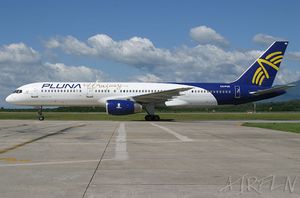
There are two variants of the 757. The 757-200 was the original, launched in 1979 with introduction into service in 1983. The 757-300 was launched in 1996 with introduction into service in 1999.
757-200
The 757-200 is the definitive version and forms the majority of 757s sold. It shares its fuselage cross section with the smaller 727 and 737. Boeing positioned the plane above the 737 and as an eventual replacement for the 727. At first it was meant to be a little shorter in length. In the end it was positioned not only above the 737, but also the 727.
This variant can carry 228 passengers in a single class. However, with a seat pitch of 29" it can carry a maximum of 234 passengers. This configuration is also the FAA limit for the aircraft due to emergency exit rules.
The -200 was available in two different door configurations. One version used three standard doors per side with an additional, smaller door aft of the wing on each side for emergency evacuations. All eight door locations are equipped with inflatable evacuation slides. The alternate version is equipped with three standard doors per side (two towards the front and one at the aft of the cabin) with two "plug-type" overwing exits per side replacing the smaller door aft of the wing.
757-200PF This proved to be a popular model after it was launched in 1985 and delivered in 1987 to UPS. The basic maximum takeoff weight of the 757PF is 250,000 pounds (113,400 kilograms), with an option for 255,000 pounds (115,600 kilograms). Other customers for the 757-200PF were Ethiopian Airlines and Challenge Air Cargo.
The 757PF has no passenger windows or doors and no interior amenities. A large main-deck cargo door is installed in the forward area of the fuselage on the left-hand side. The flight crew boards the aircraft through a single entry door installed immediately aft of the flight deck on the left side of the aircraft.

The interior of the main-deck fuselage has a smooth fiberglass lining. A fixed rigid barrier installed in the front end of the main deck serves as a restraint wall between the cargo and the flight deck. A sliding door in the barrier permits access from the flight deck to the cargo area.
Up to 15 containers or pallets, each measuring 88 by 125 inches (223 by 317 centimeters) at the base, can be accommodated on the main deck of the 757PF. Total main-deck container volume is 6,600 cubic feet (187 cubic m) and the two lower holds of the airplane provide 1,830 cubic feet (51.8 cubic m) for bulk loading. These provide a combined maximum revenue payload capability of 87,700 pounds (39,780 kilograms) including container weight. When carrying the maximum load, the 757PF has a range of about 2,900 nautical miles (5,371 kilometers).
Many former passenger 757-200s have been converted into 757-200 SF (Special Freighters), mainly for DHL. This conversion involves adding a cargo door on the left forward fuselage (identical to the 757-200PF), and removing all passenger amenities. All but the two forward cabin doors are sealed shut, and cabin windows are deleted. In September 2006, FedEx Express launched a US $2.6 billion fleet renewal initiative based on retiring its Boeing 727 aircraft acquiring second-hand Boeing 757's. Converted 757's are expected to enter service between 2008 and 2016.[2].
757-200M
This model was launched for Royal Nepal airlines. It is a convertible version where the seats can be removed in order to place cargo on the main deck. Nepal needed a plane that operate from high altitide airfields. and, having low passenger traffic, they also were in need of a plane that could be converted to a freighter. Boeing saw this as an opportunity to showcase its 757. The 737 and 747 convertibles had proved popular and saw a market potential for the 757-200M. However in the end only one example was ever manufactured and delivered, (9N-ACB). Royal Nepal still operates it.
Other versions such as a 757-200ER were proposed, but never launched. However improvements such as winglets are offered for those upgrading their fleets. Total production was 914 757-200, 80 757-200PF, and 1 757-200M. In January 2007 a total of 951 Boeing 757-200 aircraft remain in airline service. The largest operators of the aircraft include: American Airlines (140), Delta Air Lines (121), United Airlines (96), United Parcel Service (75), Northwest Airlines (50), Continental Airlines (41), US Airways (41) China Southern Airlines (25), DHL Air (21), Thomsonfly (18), Thomas Cook Airlines (15) and Icelandair (14). Some 88 other airlines also operate smaller numbers of the type.[1]
757-300
The 757-300 is a 23.4 ft stretched version of the -200, that first flew in August 1998. The 757-300 has the capacity to seat 289 passengers in a 29" pitch one class cabin, though the highest configuration in airline service is 280 seats, as operated by Thomas Cook Airlines. The fuel capacity was not increased and therefore the range was reduced to 6,287 km or 3,395 nm. 55 were ordered and delivered. This model has 8 standard doors, with 4 over-the-wing exit doors, 2 on either side. This model also features the interior of the Next Generation 737, which blends aspects of the 757-200 interior with the Boeing 777-style interior. It has proved popular with charter airlines for its efficiency and dense capacity however most airlines shied away from it. They cited its lack of range and very long yet thin fuselage as their main reason. [citation needed]
For Boeing to have increased the fuel capacity, it had to strengthen the undercarriage and other areas to increase the MTOW. The 757-300 series was available for purchase with two engine options: either 191.7kN (43,100lb) Rolls Royce RB-211-535E4-B turbofans, or 195.1kN (43,850lb) Pratt & Whitney PW-2043 turbofans. In the end, only Northwest Airlines ordered the 757-300 with the Pratt & Whitney engines, making them unique among the series. Boeing decided against further investment in the 757 family and focussed efforts on the 737 Next Generation series (specifically the 737-900ER which Boeing believes will be a suitable 757-200 replacement for most passenger applications) and the Boeing 787, which Boeing believes, in smaller versions, will substitute for larger versions of the 757 family.
In January 2007 all 55 Boeing 757-300 aircraft remain in airline service with Arkia Israel Airlines (2), ATA Airlines (4), Condor Airlines (13), Continental Airlines (17), Icelandair (1), Northwest Airlines (16) and Thomas Cook Airlines (2) [1]
Specifications
| Model | 757-200 | 757-200F | 757-300 |
|---|---|---|---|
| Cockpit crew | Two | Two | Two |
| Passengers | 200 (2-class) 238 (1-class) |
N/A | 243 (2-class) 289 (1-class) |
| Length | 47.32 m (155 ft 3 in) | 47.32 m (155 ft 3 in) | 54.47 m (178 ft 7 in) |
| Wheelbase | 18.29 m (60 ft) | 18.29 m (60 ft) | 22.35 m (73 ft 4 in) |
| Wingspan | 38.05 m (124 ft 10 in) | ||
| Wing Sweepback | 25° | ||
| Wing Aspect Ratio | 7.8 | ||
| Height | 13.56 m (44 ft 6 in) | ||
| Cabin Width | 3.54 m (11 ft 7 in) | ||
| Cabin Length | 36.09 m (118 ft 5in) | 36.09 m (118 ft 5in) | 43.21 m (141 ft 8 in) |
| Max. take-off weight | 115,680 kg (255,000 lb) |
115,680 kg (255,000 lb) |
123,600 kg (272,500 lb) |
| Cruise speed | .80 Mach | ||
| Range, loaded | 7,275 km (3,928 nm) |
5,834 km (3,150 nm) |
6,421 km (3,467 nm) |
| Max. fuel | 43,490 L (11,489 USG) | 42,680 L (11,276 USG) | 43,400 L (11,466 USG) |
| Service ceiling | 12,800 m (42,000 ft) | ||
| Engines (2×) | Rolls-Royce RB211, PW2037, PW2040, PW2043 turbofan engines,
rated at 36,600 lbf (163 kN) to 43,500 lbf (193 kN) thrust each | ||
757 Sales
Orders
| 2003 | 2002 | 2001 | 2000 | 1999 | 1998 | 1997 | 1996 | 1995 | 1994 | 1993 | 1992 | 1991 |
|---|---|---|---|---|---|---|---|---|---|---|---|---|
| 7 | 0 | 37 | 43 | 18 | 50 | 44 | 59 | 13 | 12 | 33 | 35 | 50 |
| 1990 | 1989 | 1988 | 1987 | 1986 | 1985 | 1984 | 1983 | 1982 | 1981 | 1980 | 1979 | 1978 |
| 95 | 166 | 148 | 46 | 13 | 45 | 2 | 26 | 2 | 3 | 64 | 0 | 38 |
Deliveries
| 2005 | 2004 | 2003 | 2002 | 2001 | 2000 | 1999 | 1998 | 1997 | 1996 | 1995 | 1994 | 1993 |
|---|---|---|---|---|---|---|---|---|---|---|---|---|
| 2 | 11 | 14 | 29 | 45 | 45 | 67 | 54 | 46 | 42 | 43 | 69 | 71 |
| 1992 | 1991 | 1990 | 1989 | 1988 | 1987 | 1986 | 1985 | 1984 | 1983 | 1982 | 1981 | 1980 |
| 99 | 80 | 77 | 51 | 48 | 40 | 35 | 36 | 18 | 25 | 2 | 0 | 0 |
Incidents
- Hull-loss accidents: 8 with a total of 700 fatalities (includes 125 fatalities on ground due to terrorist hijacking and subsequent crash)
- 02OCT1990 Registration: B-2812, Carrier: China Southern, Fatalities: 46 on board, Approximate Location: Guangzhou-Baiyun Airport, China
- 20DEC1995 Registration: N651AA, Carrier: American Airlines, Fatalities: 160 on board, Approximate Location: Buga, Colombia
- 06FEB1996 Registration: TC-GEN, Carrier: Birgenair, Fatalities: 189 on board, Approximate Location: Puerto Plata, Dominican Republic
- 02OCT1996 Registration: N52AW, Carrier: AeroPeru, Fatalities: 70 on board, Approximate Location: Lima, Peru
- 14SEP1999 Registration: G-BYAG, Carrier: Britannia Airways, Fatalities: None, Approximate Location: Gerona-Costa Brava Airport, Spain
- 11SEP2001 Registration: N591UA, Carrier: United Airlines, Fatalities: 44 on board, Approximate Location: Shanksville, Pennsylvania, United States
- 11SEP2001 Registration: N644AA, Carrier: American Airlines, Fatalities: 64 on board and 125 on ground, Approximate Location: The Pentagon, Arlington, Virginia, United States
- 21JUL2002 Registration: A9C-DHL, Carrier: DHL Aviation, Fatalities: 2 on board, Approximate Location: Überlingen, Baden-Württemberg, Germany
Trivia
- As of 2006 the 757 has carried 1.4 billion passengers, four times the population of the United States and Canada combined.
- The 757 fleet has flown the equivalent of nearly 29,000 roundtrips between the Earth and the Moon.
- The 757 Freighter can hold over 6 million golf balls.
- At 255,000 pounds (115,660 kilograms), the 757 weighs as much as a diesel train locomotive.
- The surface area of a pair of 757 wings is 1,951 square feet (181 square m), about the same as the floor space of a three-bedroom house in the U.S.
- There are about 626,000 parts in a 757. About 600,000 bolts and rivets fasten those parts together. The length of electrical wiring is about 60 miles (100 kilometers).
- Airlines fly the 757 on a variety of length routes. The twinjet is used to serve city pairs as far as 4,281 statute miles (6,890 kilometers) and as close as 65 statute miles (105 kilometers).
- The first Boeing 757 was delivered to Eastern Air Lines on 22 December 1982.
References
- ↑ 1.0 1.1 1.2 Boeing 757 Reference Site, 02 January 2007
- ↑ FedEx Fleet Plans.
External links
- Manufacturers website
- Boeing 757 Family
- Production of Boeing 757 will be stopped in 2004 (Boeing news release)
- Other websites
- Boeing 757 Production Lists at www.plane-spotters.net
- The Boeing 757 Website (Unofficial) at www.b757.info
- 757.org.uk - Boeing 757 reference site at www.757.org.uk
- B737-757-767 training aids - interactive instrument panels at www.artietheairplane.com
- Boeing 757 at the Aviation Safety Network Database
Related content
Related development
Comparable aircraft
Related lists
See also
Boeing airliners | |
|---|---|
| Piston-engined | |
| Jet-engined | |
| In development | |
| Proposed | |
| Not developed | 2707 · 7J7 · NLA · Sonic Cruiser |
Lists relating to aviation | |
|---|---|
| General | Timeline of aviation · Aircraft · Aircraft manufacturers · Aircraft engines · Aircraft engine manufacturers · Airports · Airlines |
| Military | Air forces · Aircraft weapons · Missiles · Unmanned aerial vehicles (UAVs) · Experimental aircraft |
| Notable incidents and accidents | Military aviation · Airliners · General aviation · Famous aviation-related deaths |
| Records | Flight airspeed record · Flight distance record · Flight altitude record · Flight endurance record · Most produced aircraft |
bs:Boeing 757 de:Boeing 757 et:Boeing 757 es:Boeing 757 fr:Boeing 757 gl:Boeing 757 ko:보잉 757 id:Boeing 757 it:Boeing 757 he:בואינג 757 ms:Boeing 757 nl:Boeing 757 ja:ボーイング757 no:Boeing 757 pl:Boeing 757 pt:Boeing 757 ru:Боинг-757 sk:Boeing 757 sr:Боинг 757 fi:Boeing 757 sv:Boeing 757 zh:波音757

